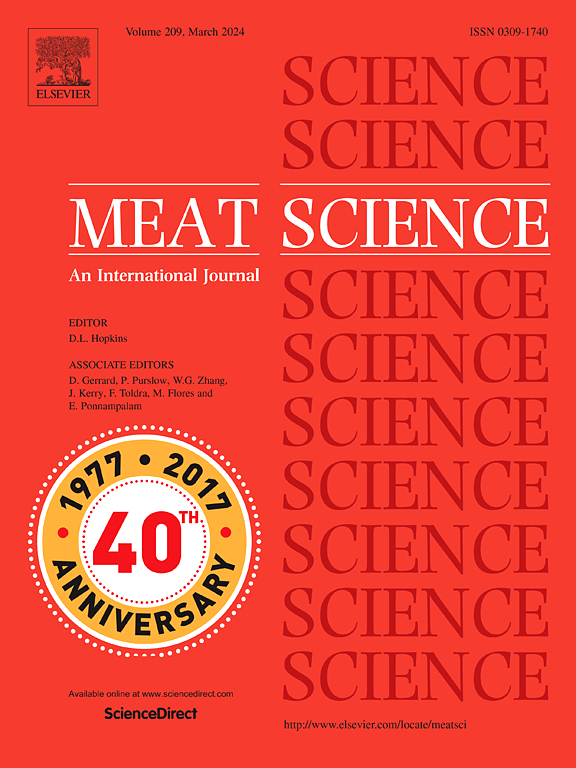用于协助剔骨室经理提高剔骨室利润的胴体战术优化工具
IF 7.1
1区 农林科学
Q1 Agricultural and Biological Sciences
引用次数: 0
摘要
通过与澳大利亚羊肉供应链合作,开发了一个整数线性编程模型,供加工商用于将胴体优化分配到不同的切割计划中,以便每天或每批在剔骨间实施。这种胴体战术优化工具(TCOT)可解决日常难题,即在胴体可用性、胴体重量和脂肪变化、产品订单数量、产品尺寸和零售价格的限制下,制定将胴体加工成产品的运营计划,同时最大限度地提高盈利能力。所有可用产品的预测重量都是根据胴体重量和脂肪率范围组合建立的切割重量预测算法得出的。胴体脂肪率以瘦肉率(LMY%)表示,并在屠宰后立即使用双能 X 射线吸收仪(DXA)对热胴体进行测量。TCOT 采用基于群体的劳动力成本模型,该模型与现实世界的供应链实践密切相关。该优化工具的功能和应用在两个对比鲜明的案例研究中进行了测试。第一个案例研究展示了优化器根据胴体重量和 LMY% 将胴体分配到最佳切割计划的能力。第二项案例研究考察了该工具对向澳大利亚国内羊肉市场供应羊肉的加工商的潜在价值,并在适用的限制条件下,证明了与当前最佳实践相比,该工具有机会将利润率提高至少 1%。这项工作提供了一条途径,使客观的胴体测量技术与胴体分拣和优化算法相结合,可用于提高羊肉供应链的盈利能力。本文章由计算机程序翻译,如有差异,请以英文原文为准。
A tactical carcass optimisation tool for assisting boning room managers to increase boning room profit
In collaboration with Australian lamb supply chains, an integer linear programming model was developed for use by processors to optimally allocate carcasses to different cutting plans for implementation in a boning room on a daily or lot basis. This tactical carcass optimisation tool (TCOT) addresses the daily challenge of developing operational plans to process carcasses into products whilst maximising profitability subject to constraints on carcass availability, variability of carcass weight and fatness, number of product orders, product size and retail prices. Predicted weights for all available products were derived from cut-weight prediction algorithms established from the combination of carcass weight and fatness ranges. Carcass fatness was expressed as lean meat yield percentage (LMY%) and measured using dual-energy X-ray absorptiometry (DXA) of hot carcasses immediately after slaughter. The TCOT utilises a group-based labour cost model which closely aligns with real-world supply chain practices. The function and application of the optimisation tool were tested in two contrasting case studies. The first case study demonstrated the ability of the optimiser to allocate carcasses to optimal cutting plans based on carcass weight and LMY%. The second case study examined the potential value of the tool for processors supplying lamb into the Australian domestic lamb market and subject to the constraints applied, demonstrated opportunities to increase profitability by at least 1 % compared to current best practice. This work provides a pathway whereby objective carcass measurement technology, combined with carcass sortation and optimisation algorithms, can be leveraged to improve profitability for lamb supply chains.
求助全文
通过发布文献求助,成功后即可免费获取论文全文。
去求助
来源期刊

Meat Science
工程技术-食品科技
CiteScore
12.60
自引率
9.90%
发文量
282
审稿时长
60 days
期刊介绍:
The aim of Meat Science is to serve as a suitable platform for the dissemination of interdisciplinary and international knowledge on all factors influencing the properties of meat. While the journal primarily focuses on the flesh of mammals, contributions related to poultry will be considered if they enhance the overall understanding of the relationship between muscle nature and meat quality post mortem. Additionally, papers on large birds (e.g., emus, ostriches) as well as wild-captured mammals and crocodiles will be welcomed.
 求助内容:
求助内容: 应助结果提醒方式:
应助结果提醒方式:


